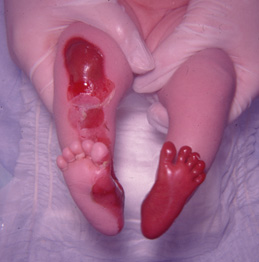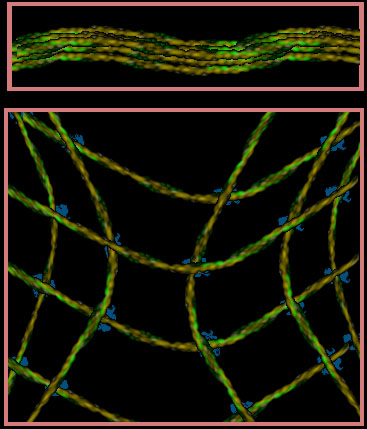|
Cell Basics
To place our main interests in perspective, we visit certain basic and general topics related to what we are, and how we work. Each of us, in our most primitive nature, is
a colony of cooperating cells. Groups of cells within that colony have specific chores as relate to the well being of the whole.
The big chores are organized - organs, liver, pancreas, heart, brain, whatever.. as so
many functions of the greater organism, yet, each cell can do just about everything the larger organs can do and then some. Indeed, subcellular anatomy is more complex and
tightly wired than the larger composite organization of the entity which we recognize as self.
Ignore the oddball and remote (viruses etc) and look at the vast uniformity of nearly all
life and we see cells. These fundamental cells have many specialized units of function within them which provide for basic common needs and other functions required by the larger composite organism.
In the cell we find a nucleus, a membrane bounded area where the DNA mostly resides. That material which encodes everything has a special talent of being able to copy
itself and thus the cell itself. When it does so, it has to divy up cellular goodies so that each resultant cell gets some of everything. All those cellular goodies are on strings - of
sorts - pulled to their destinies.
What goodies? Small units which read nucleic acid sequences and translate that into
amino acid sequences, units which stow synthesized materials into packets, units which make the cell engulf food, units which direct flow, and so many others. So, even when
we see sheets of cells all still as stuck together, within each one is much movement and that movement is NOT willy nilly but highly ordered and directed. The fact is, most
cell goodies are on conveyers and get pulled along discrete intracellular highways. The stuff that makes us bend an elbow or kick a ball is the same stuff that is within nearly
all cells and used for the same purpose - movement. Chromosomes move, and the cells narrow and divide by these same tricks.
So, motion of goodies within and cell or making whole cells walk about, uses the same
basic tools. The shape of cells is also altered or maintained by those structural materials.
Cytoskeleton:
The cytoskeleton (cyto= cell, skeleton=skeleton) is an organization of filaments within a cell which give it form and function. There are three major filaments and two of them are found universally in just about all cells of all kinds. They are :
actin, microtubules, and intermediate filaments.
Microtubules look like bamboo tubes, hollow. In cross section we see that they are made up of a circular cluster of thin solid filaments, 13 to the cluster, around a hollow center. Each of these 13 longf solid filaments is actually, on molecular inspection, a
string of pearls - or more like popit beads. Two round bead types form a single tight structural unit (tubulin) which can repeatedly lengthen by adding on more and more tubulin pairs at the leading end :
Consider one unit as >1][2> can attach to another >1][2> as a long structure:
... >1][2>>1][2>>1][2>>1][2>>1][2>>1][2>>1][2>>1][2>>1][2>...
and so on. Typically one end elongates while the other gets units trimmed away if need be.
Microtubules radiate out from an organizing area which, like a compass north pole,
gives clear polarity to movement within the cell. It is interesting that the tubulin units are made up of a protein structure which is sooo very close in form to another entity
(called GTPase). Each tubulin bead has a trapped GTP molecule within it, a filler, as a
reminder of a former simpler self, before it learned how to link up.
There are proteins which attach to microtubules. Some stay fixed and keep things still.
Some do a hand over hand walk along the tubulin and thus pull cell goodies to specific places. For example, dynein proteins move along microtubules toward an area near cell
center, a cell area that puts synthesized materials into packets - the Golgi. Reverse travelers, kinesins, move the opposite direction along other microtubules dragging new particles to the endoplasmic reticulum out at the periphery. These particles do the big knitting and pearling assembling proteins and, I suppose, want a window seat while
they work. Microtubules in a certain specialized configuration, make cell sized 'hair'-like whips that beat rhythmically.
A drug, colchicine, which binds tightly to microtubule tubulin is a powerful treatment
for gout, by strongly limiting cell internal movement required to get to and gobble the gout crystals. Another drug, taxol, so binds the assembled tubulin that it prevents
chromosomes from migrating for cell division, thus buggering up cell division (an anti cancer drug).
Intermediate Filaments are named as being mid size (in cross section) to the other filament types. These are cellular rope. These are simply strong and attached
from here to there to keep here here and there there. Look for them in abundance where wear & tear is found - nails, hair, skin. 
There are several sub types - fairly similar like long ropes with differing end attachments: keratin, vimentin, neurofilaments, nuclear lamina filaments.
The essential rope unit is a repeating sequence of 7 amino acids which tightly spiral, cross attaching by side arm attraction on each go round.
There are over 20 keratins. One type, if absent or defective, results in the generative layer of skin to
just pull apart - epidermolysis bullosa - wherein skin looks scalded and blisters off, as seen on the right.
Actin is a most universal filament. It is nearly identical in man and the most primitive single cell animals. Like tubulin, it too has a history. Hexokinase is a big pacman like
protein which takes in two molecules, one for spice (ATP) and the other to savor (glucose).
The 6 carbon glucose gets gulped and then spit out by hexokinase. This is a very very important first step in the metabolism of sugar. In the process a phosphate is tagged
onto the sugar molecule which gets the process of breaking down sugar going.
But somewhere, somehow, a hexokinase fella got the idea to bite the hair of a fellow hexokinase.
Result? Actin. Actin is a hexokinase that lost the taste for sweets and forms long strings
or filaments by attaching to other actin units. These also tightly coil on dual helix form.
Within the cell the actin filaments tend to go where the action is. A ring of actin causes
the cell to narrow and divide in cell division. It makes cells protrude, roll, withdraw and crawl. About 5% of a cell's protein is actin (20% of skeletal muscle).
 The key to actin is the company it keeps. Certain proteins cause it to bundle like thick rope. The key to actin is the company it keeps. Certain proteins cause it to bundle like thick rope.
Other proteins cause it to form grids and lattices which become gels.
And yet other proteins can walk along actin. Actin is a highway system of one way roads. Which
way depends on the other protein
A protein called myosin, near and dear to us in orthopedics, is just one of many proteins which can
walk along the actin filaments.
We will delve into those details of actin and myosin acting together as muscle in another section.
|